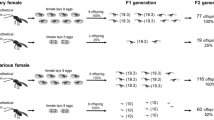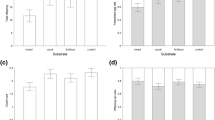Abstract
The haplodiploid genetics of the Hymenoptera, by which males and females develop from unfertilised and fertilised eggs, respectively, give rise to certain asymmetrical coefficients of relatedness among family members1–3. These asymmetries, and predictions concerning the sex ratio that are based on them2,4,5, make the Hymenoptera ideal for the study of social behaviour. Work has focused on the more highly social groups of ants, bees and wasps6–10. Although there has been considerable work on the parasitoid Hymenoptera with respect to sex ratio theory11–15, no study has examined the social interactions of gregarious parasitoids in the light of inclusive fitness theory1. I discuss here conflict among family members of a parasitoid wasp over the allocation of host resources, and argue that males are the more altruistic/less selfish sex. This provides a further explanation for hymenopteran males being generally smaller than females and for investment ratios being biased towards females4,16. Conflict is predicted between mothers and their daughters over the allocation of resources to the sexes. The observed brood sex ratios are interpreted as a means by which egg-layers equalise investment in the sexes17.
This is a preview of subscription content, access via your institution
Access options
Subscribe to this journal
Receive 51 print issues and online access
$199.00 per year
only $3.90 per issue
Buy this article
- Purchase on Springer Link
- Instant access to full article PDF
Prices may be subject to local taxes which are calculated during checkout
Similar content being viewed by others
References
Hamilton, W. D. J. theor. Biol. 7, 1–52 (1964).
Hamilton, W. D. A. Rev. Ecol. Systems. 3, 193–232 (1972).
Crozier, R. H. Am. Nat. 104, 216–217 (1970).
Trivers, R. L. & Hare, H. Science 191, 249–263 (1976).
Alexander, R. D. & Sherman, P. W. Science 196, 494–500 (1977).
Wilson, E. O. The Insect Societies (Harvard University Press, Cambridge, 1971).
Michener, C. D. The Social Behavior of the Bees (Harvard University Press, Cambridge, 1974).
West Eberhard, M. J. Univ. Mich. Mus. Zool. Publ. 140, 1–101 (1969).
Noonan, K. M. Science 199, 1354–1356 (1978).
Metcalf, R. A. & Whitt, G. S. Behav. Ecol. Sociobiol. 2, 353–360 (1977).
Hamilton, W. D. Science 156, 477–488 (1967).
Salt, G. J. exp. Biol. 13, 363–375 (1936).
Clausen, C. D. J. N. Y. ent. Soc. 47, 1–9 (1939).
Flanders, S. E. Am. Nat. 99, 489–494 (1965).
Rabinovich, J. E. Rev. Biol. Trap. 19, 109–120 (1971).
Macnair, M. R. J. theor. Biol. 70, 449–459 (1978).
Fisher, R. A. The Genetical Theory of Natural Selection (Clarendon, Oxford, 1930).
Trivers, R. L. Am. Zool. 14, 249–264 (1974).
Alexander, R. D. A. Rev. Ecol. Systems 5, 325–383 (1974).
Gerber, H. S. & Klostermeyer, E. C. Science 162, 82–84 (1970).
Oster, G., Eshel, I. & Cohen, D. Theor. pop. Biol. 12, 49–85 (1977).
Charnov, E. L. Am. Nat. 112, 317–326 (1978).
Benford, F. J. theor. Biol. 72, 701–727 (1978).
Author information
Authors and Affiliations
Rights and permissions
About this article
Cite this article
Pickering, J. Larval competition and brood sex ratios in the gregarious parasitoid Pachysomoides stupidus. Nature 283, 291–292 (1980). https://doi.org/10.1038/283291a0
Received:
Accepted:
Issue Date:
DOI: https://doi.org/10.1038/283291a0
This article is cited by
-
A Comparative Study of Sex Ratio and Clutch Size in Gregarious Ichneumonoid Wasps
Journal of Insect Behavior (2009)
-
Sex ratios
Heredity (2002)
-
Oviposition behavior and progeny allocation of the polyembryonic waspCopidosoma floridanum (Hymenoptera: Encyrtidae)
Journal of Insect Behavior (1989)
-
Sex allocation in animals
Experientia (1985)
-
Superparasitism reconsidered: is it an adaptive competition? The example ofDiadromus pulchellus
Experientia (1985)
Comments
By submitting a comment you agree to abide by our Terms and Community Guidelines. If you find something abusive or that does not comply with our terms or guidelines please flag it as inappropriate.



